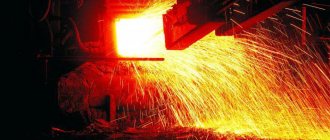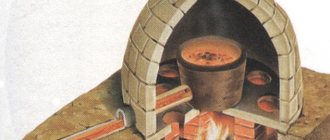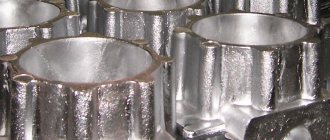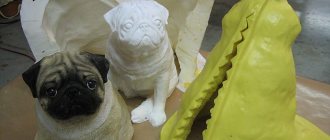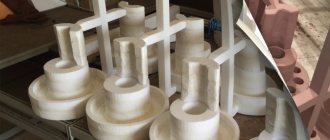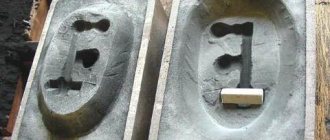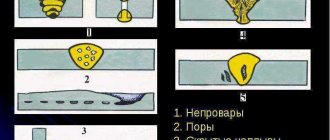The casting method is used to produce engine blocks, cylinder heads, pistons and piston rings, crankshafts, gearbox housings and covers, gear wheels, frames of machine tools and rolling mills, turbine blades, caterpillar tracks, excavator buckets and other parts that are difficult or impossible to obtain by other methods. metal processing (in particular, pressure and cutting).
Casting technology allows:
1) to obtain products of complex shapes and various sizes (internal combustion engine cylinder blocks, metal-cutting machine beds, shaped artistic castings);
2) manufacture products with minimal processing allowances (camera parts, internal combustion engine pistons). At the same time, the metal utilization factor (CMM) is at least 70%, and for injection molding - 95%;
3) manufacture products from alloys with low ductility and low machinability (excavator buckets, tracks, etc.).
For the production of castings, casting in sand-clay molds and special methods are used (lost wax casting, shell molds, chill molds, pressure casting, centrifugal casting, etc.).
When choosing a casting method, the production volume, requirements for the geometric shape of the product and surface cleanliness, the chemical composition of the metal being poured, the shape of the casting, economic considerations and other factors are taken into account.
Regardless of the casting method, in all cases a casting mold is needed to obtain a casting. Casting shape
is a structure consisting of elements that form a working
a cavity, the filling of which with a melt ensures the production of a casting of a given size and configuration.
When making castings, the casting mold is the main tool. The form provides, firstly, the necessary configuration and dimensions of the casting, secondly, the specified accuracy and quality of its surface, and thirdly, a certain cooling rate of the poured metal, which contributes to the formation of the required structure and corresponding properties of the casting.
Casting molds are divided according to the number of fills into one-time and multiple, according to the material - sand, sand-cement, gypsum, metal, highly refractory materials, etc.
The main operations of the technological process for manufacturing castings are: making a casting mold, melting metal and pouring into a mold, removing castings from a mold.
Materials scientist
For the production of castings, a casting mold is used, which is a system of elements that form a working cavity, when filled with molten metal, a casting is formed.
Casting molds are made both from non-metallic materials (sand molds, lost wax molds, shell molds) for one-time use, and from metals (chills, molds for centrifugal casting, injection molds) for repeated use.
Sand casting is the most common method for making castings. Castings are made from cast iron, steel, non-ferrous metals from several grams to hundreds of tons, with a wall thickness from 3...5 to 1000 mm and a length of up to 10,000 mm.
The essence of sand casting is to produce castings from molten metal, solidified in molds that are made from molding sands by compaction using a pattern kit.
A diagram of the technological process for manufacturing castings in sand molds is shown in Fig. 1.
Scheme of the technological process for manufacturing castings in sand molds
Rice. 1. Scheme of the technological process for manufacturing castings in sand molds
The casting mold for producing sand castings is shown in Fig. 2.
Casting shape
Rice. 2. Diagram of the casting mold
The casting mold consists of upper 1 and lower 2 mold halves, which are made in flasks 7, 8 – devices for holding the molding sand.
The flasks can be solid cast or welded. In terms of configuration, they are rectangular, round and, less often, curly. To facilitate the release of gases and water vapor, special ventilation holes are made in the walls of the flask. To hold the compacted mixture in the flask and increase the rigidity of the structure, medium and large flasks are equipped with internal ribs. To simplify the processing of flasks, the upper level of the stiffeners is often located below the sides of the flasks. For the manufacture of flasks, cast iron, steel, aluminum and magnesium alloys are used.
The half-forms are oriented using pins 10, which are inserted into the holes of the handles of the flask 11.
To form cavities of holes or other complex contours, casting rods 3 are installed in the molds, which are fixed by means of protrusions that fit into the corresponding depressions of the mold (marks).
The mold is filled with molten metal through a gating system.
The gating system is a set of channels and elements of the casting mold through which the melt flows from the pouring ladle into the mold cavity and fills it and with the help of which the casting is supplied with power during solidification.
The main elements are: sprue bowl 5, which serves to receive molten metal and feed it into the mold; riser 6 – a vertical or inclined channel for supplying metal from the sprue bowl into the working cavity or to other elements; slag catcher 12, with the help of which slag and other non-metallic impurities are retained; feeder 13 – one or more through which molten metal is supplied to the cavity of the casting mold.
To remove gases, control the filling of the mold with molten metal and feed the casting during its solidification, a vent 4 is used . Ventilation ducts 9 are also intended for the removal of gases. The gating system includes profits that compensate for the shrinkage of the casting, so they are located above the massive parts of the casting. The configuration and size of the profits are selected in such a way that the crystallization process of the casting is completed in them. For example, the thickness of the profits is always greater than the thickness of the casting in the place over which the profit is placed. There are: open (direct supply), closed (spherical and conical), operating under gas pressure (the charge of the gaseous substance is placed in the profit cavity), as well as easily detachable profits. Ease of profit separation is ensured by the use of diaphragms (separating plates) made of fireclay-clay mixtures.
There are gating systems with feeders located in horizontal or vertical planes.
According to the method of supplying the melt to the working cavity of the mold, gating systems are divided into lower (siphon), upper, side (via connector), rain, and tiered.
Based on hydrodynamic characteristics, gating systems are divided into tapering and expanding. Tapering gating systems are characterized by a consistent reduction in the cross-sectional areas of the riser, slag trap and feeders.
If there is a narrowest point in the feeders, the entire system and the slag trap are quickly filled with metal in order to better capture the slag. The flow of metal into the mold cavity occurs at high speed, which can lead to splashing and oxidation of the melt, air entrapment and mold erosion. This system is used in the production of cast iron castings.
In expanding systems, the bottleneck is located in the lower section of the riser. The flow rate from the riser to the feeders is reduced, the metal enters the cavity calmly, with less splashing, oxidizing less and destroying the walls of the mold. Expanding systems are used in the manufacture of castings from steel, aluminum, magnesium and other easily oxidized alloys.
Some types of gating systems are shown in Fig. 3.
Types of gating systems
Rice. 3. Types of gating systems: a – side; b – lower (siphon); c – upper; 1 – feeders; 2 – slag catcher; 3 – riser; 4 – sprue bowl; 5 – casting; 6 – thrust; 7 - collector
The lower gating system (Fig. 3, b) is widely used for casting alloys that are easily oxidized and saturated with gases (aluminium), it ensures a calm supply of the melt to the working cavity of the mold and its gradual filling with metal arriving from below without an open jet. At the same time, the design of the gating system becomes more complicated, the consumption of metal for it increases, and an unfavorable temperature distribution is created in the poured mold due to the strong heating of its lower part.
The formation of shrinkage defects and internal stresses is possible. With such a system, the possibility of obtaining high thin-walled castings is limited (when casting aluminum alloys, the mold is not filled with metal if the ratio of the height of the casting to the thickness of its wall exceeds 60, H/δ≥60).
Bottom supply through a large number of feeders is often used in the manufacture of complex-shaped, large cast iron castings.
Upper gating system (Fig. 3c).
The advantages of the system are: low metal consumption; the design is simple and easy to implement when making molds; feeding the melt from above ensures a favorable temperature distribution in the poured mold (the temperature increases from the bottom to the top), and therefore favorable conditions for directional crystallization and feeding of the casting.
Disadvantages: a stream falling from above can wash away the sand mold, causing blockages; when the melt is sprayed, there is a danger of its oxidation and mixing of air into the flow with the formation of oxide inclusions; slag collection becomes difficult.
The upper gating system is used for low (in the pouring position) castings, light mass and simple shape, made from alloys that are not prone to strong oxidation in the molten state (cast iron, carbon structural steel, brass).
Side gating system (Fig. 3, a).
The metal supply is carried out in the middle part of the casting (along the mold connector).
This system is used to produce castings from various alloys, small and medium-weight parts, the plane of symmetry of which coincides with the parting plane of the mold. It is intermediate between the upper and lower and, therefore, combines some of their advantages and disadvantages.
Sometimes, when supplying metal from below and above, massive collectors 7 are used.
With a rain gating system, the melt is supplied from above through several feeders (small diameter holes).
With a tiered gating system, the melt is supplied at several levels. The feeders operate sequentially, starting from the bottom ones, as the metal level in the mold cavity rises. These systems, which provide quiet filling and hot metal at the head of the flow, are widely used in the production of large and thin-walled castings from ferrous and non-ferrous alloys.
The vertical slot (storey) system is a type of tiered system and is used, for example, in stack molding of small castings. To separate large slag inclusions, filters (ceramic meshes) are sometimes installed in the sprue bowl.
Jewelry casting at home for beginners
But how are we going to fuse paraffin onto a ring when it is incredibly fluid and unpredictable? It turned out that everything is much simpler. In the process, the master realized that paraffin remains plastic for a long time and can be deformed like plasticine. And so it happened. He simply molded the desired ring shape and continued. True, it wouldn’t hurt to go through a soldering iron in order to fuse the molded boundaries. But the master decided not to do this. Later on the castings this will appear as a defect, but not so bad that you can’t wear this ring. Now we need to process the molded model. The master decided to do it with sandpaper, but he doesn’t remember whether it was forty or sixty, but it was definitely very rough. And again for good reason. The fact is that a large grain of sandpaper leaves a deep mark on the paraffin and gives it texture. Therefore, carefully walking along the front part of the ring with coarse sandpaper, we will leave the resulting texture for casting. Since the paraffin could fail at any moment, the master decided to leave the finishing work to the brass casting.
We put the model aside and prepare the bases for fixing the model. The simplest thing is to make it from plasticine. We knead it and sculpt a hemisphere into which we will install sprues in the future, and subsequently this sphere will become a kind of pocket for melting metal before pouring. Therefore, you should not make the sphere too flat. It is necessary that all the molten metal fits in it. By the time of casting you will understand everything and see for yourself what it looks like.
As a flask (a metal mandrel for pouring the molding mixture), you can take a very ordinary metal pipe; for example, a plumbing store should have pieces of a suitable size.
We will make the sprues from 2 nails. We bite off the excess with pliers and install them in our plasticine sphere. After installing them, we somehow need to attach the wax model to the metal sprues. To do this, the author decided to take a burner and slightly heat the nails, and then lean the ring against them. Hot nails will easily melt the paraffin and go deep into the model.
And actually, it turned out quite well. When the plaster gets stronger, you can clean the mold from sagging and separate the plasticine from the sprues. Now comes the most crucial moment - the moment of calcination of the mold. In the instructions for the molding compound, there is a map that indicates the calcination cycle of 15 hours. But since this goes against knee technology, it would be fair to reduce this time to 40 minutes.
This is bad and wrong, but still possible. The main thing here is to provide gentle heating at first, so that the water from the plaster begins to evaporate, and the paraffin begins to smoothly melt and flow out. The master used a roofing torch for this, since he had one. You can get by with a household burner, or you can start with a very ordinary oven, it will be more correct. Just don’t forget to place the mold with the sprues down in some kind of tray so that there is somewhere for the paraffin to drain.
You can pour metal at home in several ways: using potatoes, clay, or any other dense, moisture-containing material. But the author has never mastered this method, so he will cast metal using a manual centrifuge.
It looks like a glass with four bolts (for more reliable fixation of the flask), a chain and a handle made of PVC pipe with bearings inside (for long-term unhindered torsion).
The author welded this thing himself, but you can get by with, for example, a metal mug.
We heat the mold until red and prepare to pour the brass. As a starting material, you can take brass plumbing fittings. They're great for this. Well, or if you are braver, you can immediately pour silver or even gold. There are no restrictions on metal in knee technologies.
Now we need to process the ring. The author did not take a drill, but cleaned everything up with files and sandpaper. Everything is real, but the only difference is the time and labor intensity of the classes.
After rough processing, the author decided to try on the ring, but it turned out that it did not quite fit.
After finishing sanding the ring, you can blacken its front part in order to give visual depth to our relief left by the coarse grain of sandpaper. For this we need pharmaceutical sulfur ointment. We apply a thin layer to the brass surface that we want to blacken and heat the ring. We heat until all the ointment burns out and a dry matte surface remains.
Types of molding
They are determined by the type of model and the chosen casting method.
According to a simple model
The model is placed face up on the board. Center it relative to the flask. Cover with a facing mixture, then add filler in layers, carefully compacting each layer. Add soil to the flask until it is filled. Having removed the upper flask, take out the model and create a gating system. The flasks are collected together, secured and dried.
According to split model
The method significantly simplifies the technology and increases the accuracy of manufacturing the casting mold. A part of the model without spikes is placed on the board, the lower flask is installed and the ground is shaped. Upon completion, the structure is turned over, the second part is attached to the model, the upper flask is attached and it is stuffed.
With false cover
For particularly complex product geometry, I use false pins. It does not come into contact with the melt, but plays the role of a figured fake board.
Forming methods
Lumpy
It is used for artistic casting, especially sculptural compositions. The model is furnished with several independent flasks, their edges touching. Sometimes a casting is divided into segments that are relatively simple in configuration, they are modeled and cast independently, and then the finished castings are connected.
Template
It is produced by casting products of a certain shape into the ground. Distinguish
- Bodies of rotation (cylindrical, conical and elliptical)
- Rectangular or prismatic.
The formation of the earth is carried out by a template of the appropriate configuration, driven by a powerful spindle for bodies of rotation or moving along special guides for prismatic shapes.
Rod signs
Each casting core is set in a sand mold before molten aluminum is poured. To ensure the installation of the rod in a strictly specified location, special grooves are provided for it on the model - rod marks. In these grooves, the rod is securely installed in the desired location.
However, even when installed in rod signs, the rod can move, for example, float under the influence of buoyant forces in the molten aluminum. These problems are less with aluminum than with other metals. The fact is that the greater the density of the molten metal, the greater these buoyant forces.
Therefore, for additional support of the rods, special devices are used - draws. Lobbies are small metal parts that are installed between the core and the surface of the mold cavity. Lots are made of metal with a higher melting point than that of the melt being poured. After hardening, the castings remain inside the casting, and the excess material of the castings that protrudes beyond the boundaries of the casting is removed when it is cut off.
Preparing parts
Home casting requires special preparation, as well as the availability of certain tools, among which we should highlight:
- Aluminum scrap. Many products can be used as scrap, including wire. But you should choose a softer one, as it contains less oxides.
- Gypsum. Molds for casting aluminum at home are best made from sculptural plaster. But its cost is quite high, so ordinary white plaster is quite suitable. It is easy to find at any hardware store. The main thing is not to confuse it with alabaster, which looks like white plaster, but is absolutely not suitable for casting.
- Wax or paraffin. Wax is the best option, but paraffin is cheaper and easier to find. You can use regular candles by removing the wick and melting them.
- Melting containers. To melt paraffin, you can use ordinary tin containers, but for melting aluminum it is recommended to use containers made of stainless steel or cast iron.
- Source of high temperature. You can use either specialized muffle or crucible furnaces, or conventional gas burners. The choice of heating source is individual and depends on the volume of molten metal required.
Homemade smelting forge
Characteristics of foundry sand
The quality of sand used to make foundry molds greatly influences the quality of the casting. The quality of sand as a molding material for casting molds is determined by the following five main characteristics:
- strength;
- gas permeability;
- thermal stability;
- subsidence ability;
- reuse .
Gas permeability
The ability of sand to pass through gases trapped in the melt, which are released during solidification. High permeability can reduce the porosity of the casting, and low permeability can give better surface quality. The degree of gas permeability depends on the size and shape of the sand grains.
Thermal stability
The ability of sand to resist damage, such as cracking, when exposed to the heat of molten metal.
Non-stick coatings
To improve the surface cleanliness of castings, non-stick coatings - paints - are applied to the working surfaces of the molds and cores. The coating is a mixture of dust-like refractory material with water and binders. The applied layers of paint reduce the roughness of the forms and close the pores between the grains of sand. As a result, the surface of the casting is smoother and cleaner, without burning.
Iron casting molds are coated with carbon-containing coatings consisting of graphite, bentonite, water and other substances.
Non-stick mixtures for steel castings include dusted quartz, zircon, magnesite, and for castings made of non-ferrous metals, fine talc. Coatings are applied to both hot and cold molds. Coatings are also used for surface modification and alloying.
ZhSS technology
Liquid glass mixture technology is used where increased demands are placed on the quality of the casting surface. Liquid glass is added to the mixture and the resulting composition is poured into the model. Carbon dioxide is introduced into the flask. The reaction takes place, and the LSC acquires hardness. It is required to obtain two half-forms, which are connected after they are cured and the model is removed. This creates a shell around which the filling mixture is formed.
Liquid glass
The quality of the casting surface in contact with a layer of smooth glass often makes it possible to do without even subsequent mechanical processing. The remaining mixture is knocked off the casting using a shot blasting machine.
Shell casting
To cast metals using this method, a composition is prepared from sand and a powdered binder, most often phenol-formaldehyde resins.
The model or mock-up is heated to 300 °C and sprinkled with the prepared mixture. In a short time (about a minute) a hardened layer is baked on the surface of the model. Excess mixture is removed.
Sometimes the clad mixture is blown into the gap between the heated model and the figured flask. The next stage is firing at a temperature of 650 °C for final strength gain. After removing the model, the halves of the matrix are connected together - and it is ready for casting. To prevent the matrix from being deformed by the weight of the melt entering it, it is surrounded by a metal box, which is filled with shot. The shot also improves the cooling schedule of the product.
Shell casting
Main advantages of the method:
- significant reduction in labor intensity and time for preparing the mold compared to casting in the ground
- control of the cooling mode of the product
- the process can be mechanized
Forming tools
According to their purpose they are divided into two main types
- Stamping boards
- Shovels and shovels for earth
- Sita
- Tampers: with a blunt end for compacting the surface and with a narrow end for places with difficult terrain. Universal pneumatic rammers with a replaceable tip are also used.
- A scraper, or rule, for leveling the mixture and removing its excess
- Mallets - used for holding sub-models together and for beating them out.
- The flutter is a board resting on the edges of the mold. Compacts the ground when using models made of low-strength materials.
- Brushes. Clean the surface from any remaining soil
Stuffing caps. Thin sharp rods are used to pierce thin gas outlet channels in the ground
- Smoothing irons - for correcting blemishes
